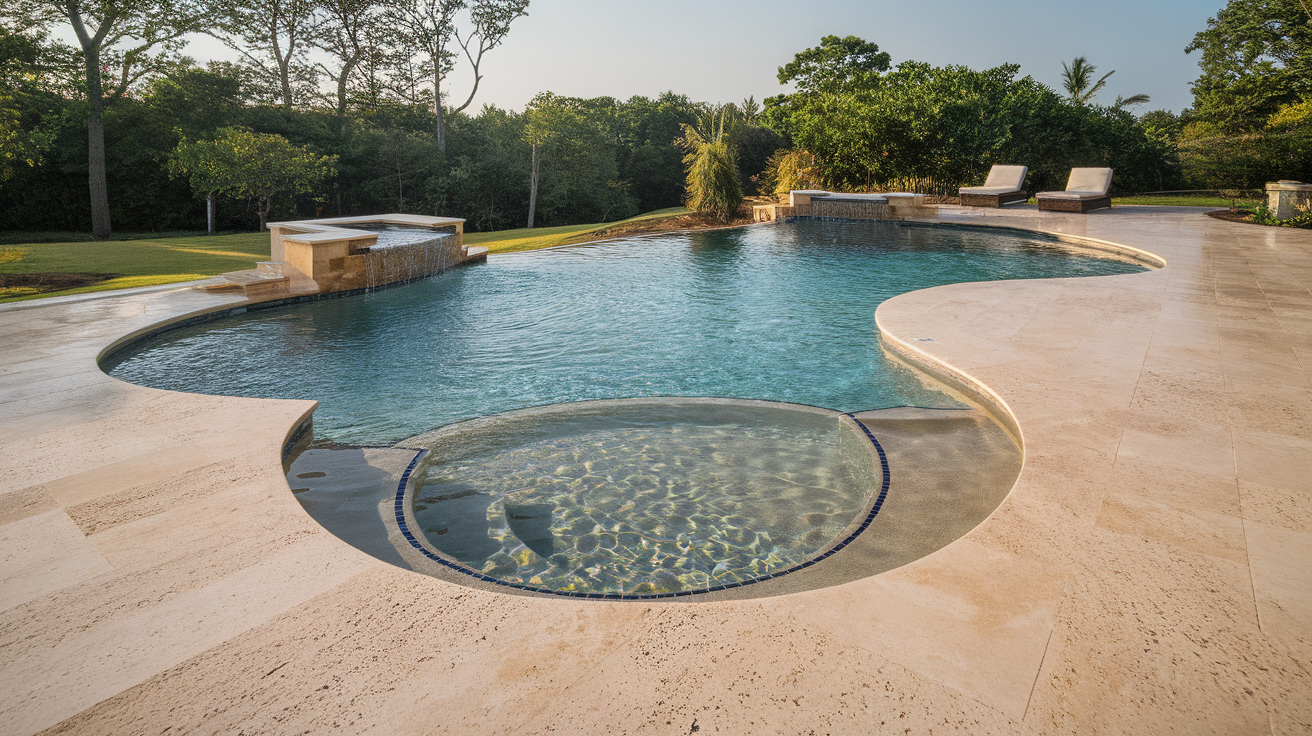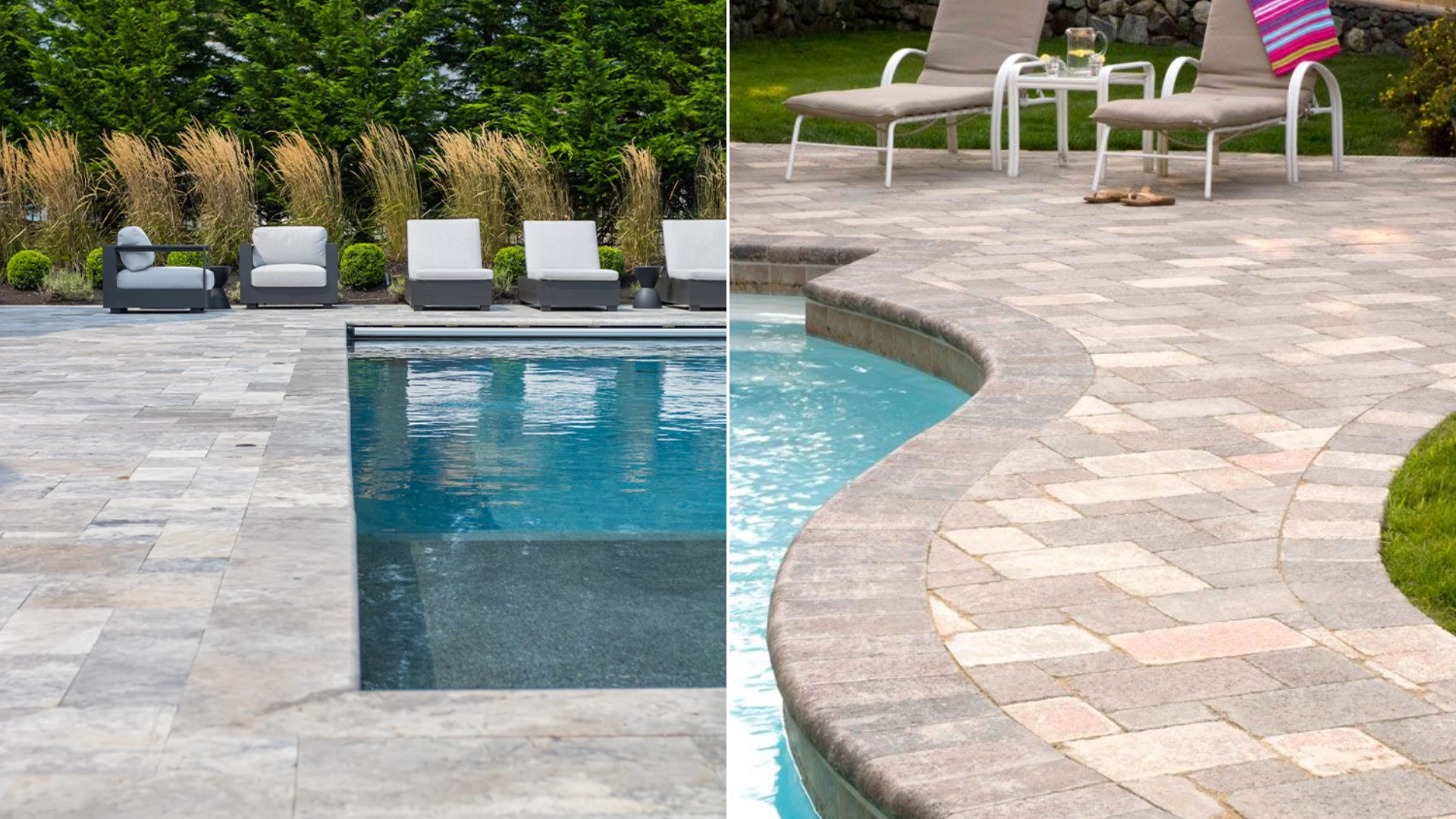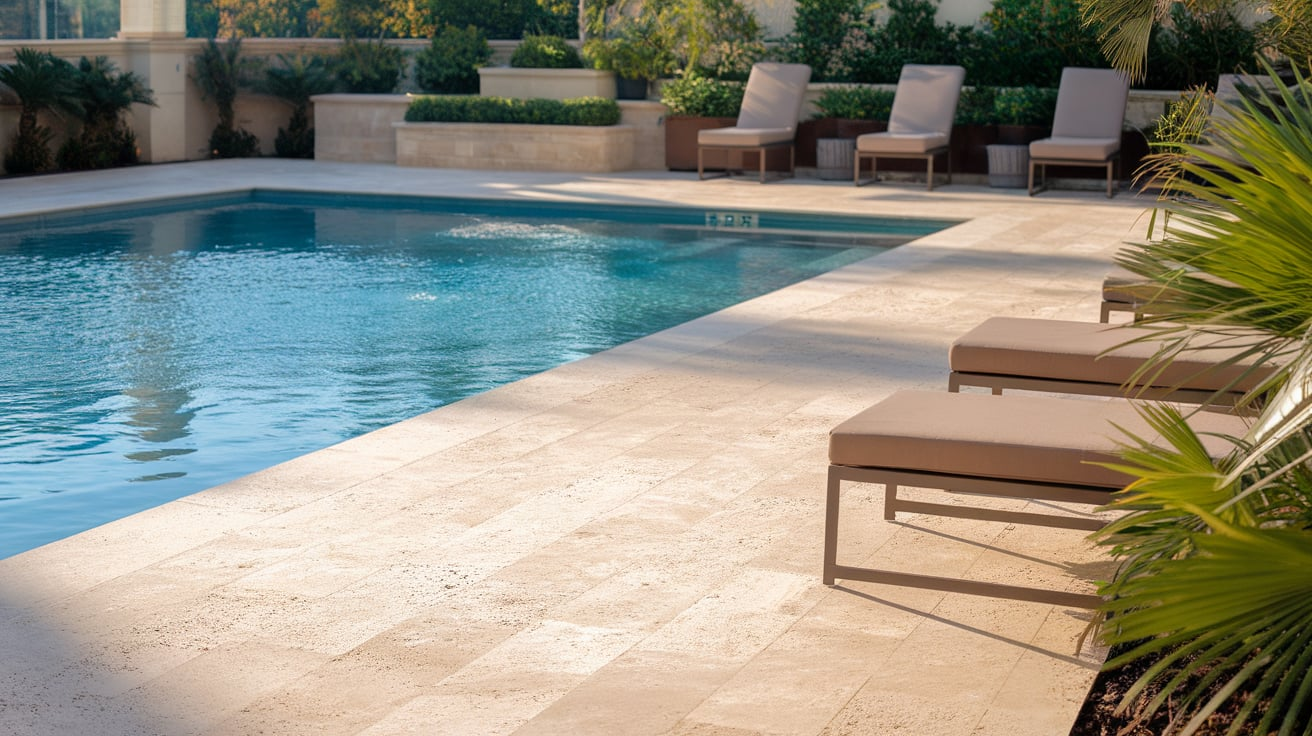Travertine pool decking is a fantastic choice for creating a beautiful, durable, and long-lasting outdoor space around your pool.
As a natural stone, it brings a timeless appeal that enhances the overall aesthetic of your pool area.
I’ve chosen travertine for its unique blend of style and practicality, offering a variety of colors and textures to suit any poolside setting.
What I love most about travertine is its slip-resistant properties, which make it perfect for pool decks, as well as its ability to stay cool underfoot even on the hottest days.
In this blog, I’ll guide you through the many benefits of travertine, helping you understand why it’s an ideal choice for anyone looking to upgrade their pool area.
Ready to transform your pool space with travertine decking? Let’s find out how you can make this stylish and durable choice a reality!
What is Travertine Pool Decking?

Travertine is a type of natural limestone formed over thousands of years in mineral-rich hot springs and caves.
Made mostly of calcium carbonate, this stone has a signature look with small holes and veins that give it a textured, earthy feel.
It comes in a wide range of natural colors—like beige, ivory, tan, gold, and reddish-brown—making it easy to match any outdoor design.
Travertine is also available in different finishes: honed for a smooth look, tumbled for a rougher texture, and polished for a glossy shine. These options let you pick a style that fits your pool area best.
But travertine isn’t just pretty, it’s also practical. It stays cool underfoot, even in hot sun, and its natural grip helps prevent slips when wet.
It stands up well to water, pool chemicals, and changing weather, making it a low-maintenance, long-lasting choice for pool decks that need to look good and perform well.
Benefits of Travertine Pool Decking
Travertine pool decking offers slip resistance, coolness underfoot, durability, aesthetic appeal, and low maintenance. Its natural beauty, safety features, and long-lasting qualities make it a perfect choice for poolside areas.
1. Slip Resistance and Safety
One of the primary reasons homeowners choose travertine for pool decking is its superior slip resistance. The stone’s natural texture, with its small holes and veins, provides excellent traction, even when the surface is wet.
Travertine’s slip-resistant qualities make it a safer option than other materials, such as concrete, which can become slippery when wet.
2. Cool Underfoot
Travertine is also known for its ability to stay cool underfoot, making it an ideal material for pool decks.
Unlike concrete, which can get unbearably hot under direct sunlight, travertine absorbs heat slowly and releases it gradually.
This ensures that your pool deck remains comfortable to walk on, even on the hottest summer days. No more burning your feet on sunbaked concrete!
3. Durability and Longevity
Travertine is incredibly durable and can stand up to the test of time. It is highly resistant to fading, staining, and cracking, even when exposed to harsh weather and the wear and tear of regular foot traffic.
Travertine pool decking is particularly resistant to water damage, making it an excellent choice for areas frequently exposed to moisture.
Unlike wood, which can warp or splinter, or concrete, which can crack, travertine is built to last, offering years of beauty and functionality with minimal maintenance.
4. Aesthetic Appeal
Travertine is a visually stunning material, offering a luxurious and timeless look that can enhance the overall aesthetic of your pool area.
The stone’s natural color variations, such as beige, gold, and tan, give it a warm, inviting appearance that complements various outdoor settings.
Plus, its natural texture adds depth and dimension to your poolside, making it an attractive feature of your backyard.
5. Low Maintenance
Maintaining a travertine pool deck is relatively simple compared to other materials. Travertine is naturally resistant to dirt, grime, and algae buildup, which means it doesn’t require frequent cleaning.
A regular sweep to remove debris, followed by washing with mild soap and water, is usually enough to keep it looking great.
Additionally, travertine only needs to be resealed every 1-2 years to maintain its appearance and protect it from moisture.
Cost of Travertine Pool Decking
The cost of installing travertine pool decking can vary depending on several factors, including the quality of the stone, the finish, the size of the area, and the complexity of the installation.
On average, the cost of travertine ranges from $15 to $30 per square foot, including materials and installation.
While the upfront cost may be higher than alternatives like concrete or pavers, the long-term benefits, such as durability, minimal maintenance, and aesthetic appeal, make it a worthwhile investment for many homeowners.
- Materials: Travertine typically costs between $5 and $15 per square foot, depending on the quality and finish.
- Labor: Installation costs typically range from $5 to $10 per square foot, depending on your location and the project’s complexity.
- Sealing: Sealing the surface after installation may add another $1 to $2 per square foot.
For a typical pool deck of 400 to 600 square feet, the total cost for travertine installation can range from $6,000 to $18,000.
Types of Travertine Finishes for Pool Decking
When selecting travertine for your pool deck, the finish you choose can significantly impact the overall look and feel of the space.
1. Tumbled Finish
A tumbled finish gives travertine a weathered, rustic look with a rough texture. This finish enhances traction and provides natural slip resistance, making it ideal for pool decks.
The uneven surface adds a charming, Mediterranean-style aesthetic that complements outdoor spaces and ensures safety in wet conditions.
2. Honed Finish
The honed finish is smooth and matte, offering a more refined and sophisticated appearance. This finish gives travertine a sleek appearance without compromising slip resistance.
It’s perfect for those seeking a modern, polished aesthetic for their pool deck, offering both elegance and safety around the pool area.
3. Polished Finish
A polished finish gives travertine a glossy, sleek surface that reflects light, adding an upscale, luxurious feel.
While visually stunning, it may be less slip-resistant compared to tumbled or honed finishes. This finish is best for dry areas or spaces with low foot traffic, where aesthetics take priority over safety.
Travertine Pool Decking vs Pavers

Travertine offers a seamless, elegant look with low maintenance and durability, while pavers provide design flexibility and affordability. Both are durable options, with travertine requiring less upkeep over time.
| Feature | Travertine Pool Decking | Pavers |
|---|---|---|
| Appearance | Provides a smooth, seamless look with natural elegance. | Can have visible joints, offering a more segmented design. |
| Durability | Highly durable, resistant to cracking, fading, and staining. | Durable but can shift or crack over time. |
| Maintenance | Requires minimal maintenance—regular cleaning and resealing. | Requires more upkeep, including joint refilling and cleaning. |
| Slip Resistance | Excellent natural slip resistance due to texture. | Slip resistance varies based on material and finish. |
| Cost | Generally higher upfront cost due to material and installation. | Typically more affordable, especially for basic designs. |
| Installation | Requires professional installation due to stone handling. | Can be installed by DIYers or professionals with more flexibility in layout. |
| Design Flexibility | Limited in design variations but offers timeless elegance. | Offers more design flexibility with different shapes, colors, and patterns. |
| Temperature | Stays cool underfoot, even in direct sunlight. | May become hotter under the sun, depending on the material. |
Maintenance Tips for Travertine Pool Deck
To keep your travertine pool deck looking great and lasting for years, follow these simple care tips:
- Regular Cleaning: Sweep the deck regularly to remove dirt, leaves, and debris. Use a mild soap and water solution to clean the surface and avoid harsh chemicals that can damage the stone.
- Seal the Surface: Reseal your travertine every 1-2 years to protect it from stains, moisture, and UV damage. Sealing helps maintain its appearance and prevents water from seeping into the stone.
- Avoid Abrasive Tools: When cleaning, avoid using abrasive brushes or tools that could scratch the surface. A soft cloth or mop is ideal for keeping it smooth.
- Address Spills Quickly: Clean up spills from pool chemicals or food immediately to prevent staining or discoloration.
By following these easy steps, you can keep your travertine pool deck beautiful and functional for years.
Conclusion
I hope this guide has helped you understand why travertine is an excellent choice for your pool decking.
Its combination of beauty, durability, and minimal maintenance makes it the perfect option for anyone looking to enhance their outdoor space.
If you’re attracted to its slip resistance, natural elegance, or ability to stay cool underfoot, travertine offers many advantages that make it ideal for poolside areas.
While it may require a slightly higher investment upfront, its long-lasting qualities and low upkeep will provide excellent value over time.
Ready to transform your pool area into a stunning, functional space? Let’s make it happen!

